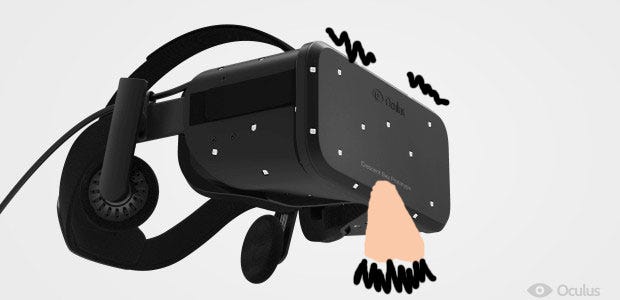Virtual Nose Could Help Battle VR Sickness
Nothing to sniff at
Virtual noses. That's what researchers at Purdue University are proposing as a potential solution to that sickness you might experience when playing games on Oculus Rift or similar virtual reality headsets.
Simulator sickness is a form of motion sickness. The version I've experienced with VR involved sweating, nausea, eyestrain and headaches. I wasn't actually sick but it was incredibly unpleasant and has made me wary of VR headsets ever since.
There are a number of theories as the exactly why this occurs with virtual reality environments but David Whittinghill - an assistant professor at the university's Department of Computer Graphics Technology - mentions the one I've heard put forward most often: cue conflict.
"The problem is your perceptual system does not like it when the motion of your body and your visual system are out of synch," says Whittinghill. "So if you see motion in your field of view you expect to be moving, and if you have motion in your eyes without motion in your vestibular system you get sick."
Cockpits and dashboards have been used as a kind of workaround as they offer players fixed visual reference points which - anecdotally, at least - appear to help. But that's only useful when the conceit of the game allows for said cockpit or dashboard.
Step forward the virtual nose.

Image: David Whittinghill/Purdue University
"It was a stroke of genius," said Whittinghill. "You are constantly seeing your own nose. You tune it out, but it's still there, perhaps giving you a frame of reference to help ground you."
Are you currently going cross-eyed trying to look at your own nose? I definitely didn't do that.
Anyway, apparently the researchers then put 41 players in two VR applications - one was that Tuscany villa, the other was a rollercoaster - some with virtual noses inserted onscreen and some without.
Apparently, taking the virtual nose to Tuscany let players stay an average of 94.2 seconds longer in the application without feeling sick than the no-nose group managed while the rollercoaster noses added 2.2 seconds of non-sickness to the experience.
"Surprisingly, subjects did not notice the nasum virtualis while they were playing the games, and they were incredulous when its presence was revealed to them later in debriefings," Whittinghill said.
I really get the feeling these quotes and press release were not written with an entirely straight face, don't you?
Something I'm wondering is about whether adding a nose would affect immersion even though some people don't apparently consciously perceive it. Looking at the image the researchers posted, the nose is pale beige. I'm assuming it's just a placeholder to test a concept but it made me think of an ongoing issue in fashion where the colour often referred to as "nude" isn't actually applicable to a huge range of people's skin tone. If the concept gets widely adopted you'd need to let people - for want of a better phrase - pick their own nose.
The research is ongoing and the overall goal of Whittinghill and his colleagues' work is to come up with a fully predictive model so you can work out what level of simulator sickness someone can expect from a given experience. But according to their research abstract, "These findings reveal a practical, inexpensive means of reducing simulator sickness in virtual reality applications."








